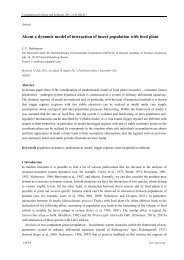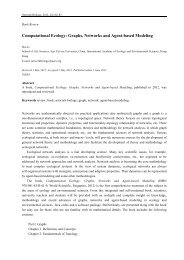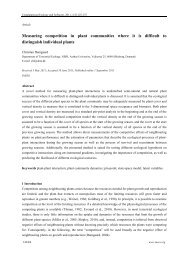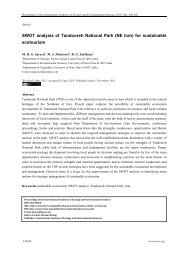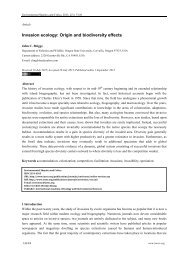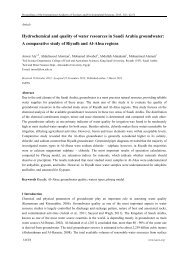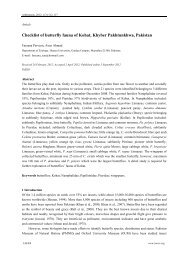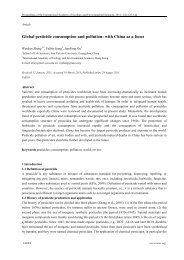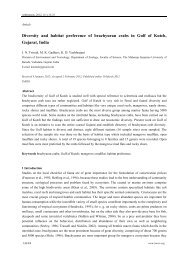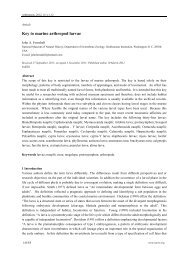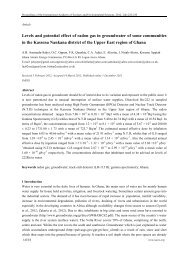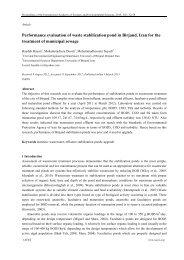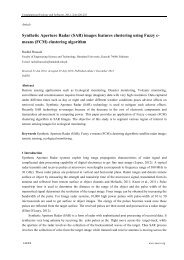Quality control analysis of imported fertilizers used in Ghana: the ...
Quality control analysis of imported fertilizers used in Ghana: the ...
Quality control analysis of imported fertilizers used in Ghana: the ...
Create successful ePaper yourself
Turn your PDF publications into a flip-book with our unique Google optimized e-Paper software.
Proceed<strong>in</strong>gs <strong>of</strong> <strong>the</strong> International Academy <strong>of</strong> Ecology and Environmental Sciences, 2012, 2(1):27-40<br />
33<br />
Beer-Lambert law (Harris, 1982).<br />
A= - log 10 (I/I o ) = ϵ·c·L<br />
A = - log(%T / 100%)<br />
where A is <strong>the</strong> measured absorbance, I 0 is <strong>the</strong> <strong>in</strong>tensity <strong>of</strong> <strong>the</strong> <strong>in</strong>cident light at a given wavelength, I is <strong>the</strong><br />
transmitted <strong>in</strong>tensity, L is <strong>the</strong> path length through <strong>the</strong> sample, and C is <strong>the</strong> concentration <strong>of</strong> <strong>the</strong> absorb<strong>in</strong>g<br />
species.<br />
Stock solutions A and B were first prepared to be <strong>used</strong> later <strong>in</strong> <strong>the</strong> <strong>analysis</strong>. Their preparations were as<br />
follows:<br />
Stock solution A; Prepared by dilut<strong>in</strong>g 140ml <strong>of</strong> conc. H 2 SO 4 with distilled water to 1 litre; 12 grams <strong>of</strong><br />
ammonium molybdate was weighed and dissolve <strong>in</strong> distilled water to 250ml <strong>in</strong> a 250ml volumetric flask;<br />
0.2908gram <strong>of</strong> Antimony potassium tartrate was weighed and dissolved <strong>in</strong> 100ml <strong>of</strong> distilled water; <strong>the</strong> three<br />
solutions were <strong>the</strong>n mixed toge<strong>the</strong>r and made to a volume <strong>of</strong> 2 litres with distilled water to represent stock<br />
solution A.<br />
Stock solution B; Prepared by dissolv<strong>in</strong>g 1.056grams <strong>of</strong> Ascorbic acid with <strong>the</strong> whole <strong>of</strong> stock solution A<br />
and mixed thoroughly.<br />
0.1gram <strong>of</strong> <strong>the</strong> sample was weighed <strong>in</strong>to a digestion tube, 20ml <strong>of</strong> HNO 3 and 30ml <strong>of</strong> perchloric acid were<br />
added to <strong>the</strong> sample <strong>in</strong> a ratio <strong>of</strong> 1:1.5. The result<strong>in</strong>g mixture was heated <strong>in</strong> a microwave oven at a temperature<br />
<strong>of</strong> 350°C for two hours. The digested sample was allowed to cool and transferred to a 250ml volumetric flask<br />
and made to volume with distilled water. An aliquot <strong>of</strong> 2ml was taken from <strong>the</strong> 250ml solution <strong>in</strong>to a 50 ml<br />
volumetric flask and 10 ml <strong>of</strong> distilled water was added. A drop <strong>of</strong> paranitrophenol solution was added and<br />
drops <strong>of</strong> NH 3 solution was added until <strong>the</strong> solution turned yellow; at this po<strong>in</strong>t a neutralization po<strong>in</strong>t had been<br />
reached.<br />
8ml <strong>of</strong> stock solution B was <strong>the</strong>n added for colour development which was read with a UV/visible<br />
spectrophotometer at a wavelength <strong>of</strong> 712nm.<br />
A blank and a standard were prepared <strong>in</strong> <strong>the</strong> same way as <strong>the</strong> sample just that <strong>the</strong> blank did not conta<strong>in</strong> <strong>the</strong><br />
analyte <strong>of</strong> <strong>in</strong>terest.<br />
The read<strong>in</strong>g from <strong>the</strong> blank was <strong>used</strong> to elim<strong>in</strong>ate background read<strong>in</strong>gs.<br />
The calculation for determ<strong>in</strong><strong>in</strong>g phosphorous (P) was:<br />
% P = Read<strong>in</strong>g × volume <strong>of</strong> extract × 100<br />
Weight <strong>of</strong> sample × aliquot × 10 6<br />
The above calculation gave <strong>the</strong> concentration <strong>of</strong> <strong>the</strong> phosphorous <strong>in</strong> its elemental form. In order to<br />
determ<strong>in</strong>e <strong>the</strong> value <strong>of</strong> phosphorous <strong>in</strong> <strong>the</strong> P 2 O 5 form, a conversion factor <strong>of</strong> 2.29 was <strong>used</strong>, thus:<br />
% P 2 O 5 = Read<strong>in</strong>g × volume <strong>of</strong> extract × 100 × 2.29<br />
Weight <strong>of</strong> sample × aliquot × 10 6<br />
where Volume <strong>of</strong> extract = 250ml; Aliquot= 2ml; Weight <strong>of</strong> sample = 0.1gram; Read<strong>in</strong>g = read<strong>in</strong>g from <strong>the</strong><br />
UV/Visible spectrophotometer.<br />
2.3.4 Determ<strong>in</strong>ation <strong>of</strong> potassium (K 2 O) us<strong>in</strong>g <strong>the</strong> flame photometer<br />
Flame photometry is an atomic emission method for <strong>the</strong> rout<strong>in</strong>e detection <strong>of</strong> metal salts, pr<strong>in</strong>cipally Na, K, Li,<br />
IAEES<br />
www.iaees.org



